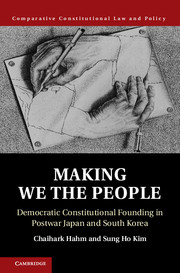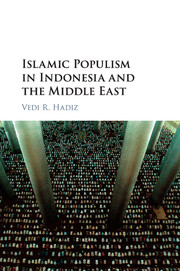1714 results in South-East Asian government, politics and policy
Note on Romanization and Sources
-
- Book:
- Making We the People
- Published online:
- 05 December 2015
- Print publication:
- 10 December 2015, pp 287-288
-
- Chapter
- Export citation
Conclusion
-
- Book:
- Making We the People
- Published online:
- 05 December 2015
- Print publication:
- 10 December 2015, pp 275-286
-
- Chapter
- Export citation
Contents
-
- Book:
- Making We the People
- Published online:
- 05 December 2015
- Print publication:
- 10 December 2015, pp ix-x
-
- Chapter
- Export citation
Glossary
-
- Book:
- Making We the People
- Published online:
- 05 December 2015
- Print publication:
- 10 December 2015, pp 305-308
-
- Chapter
- Export citation
2 - War and Peace
-
- Book:
- Making We the People
- Published online:
- 05 December 2015
- Print publication:
- 10 December 2015, pp 66-127
-
- Chapter
- Export citation
Copyright page
-
- Book:
- Making We the People
- Published online:
- 05 December 2015
- Print publication:
- 10 December 2015, pp vi-vi
-
- Chapter
- Export citation
4 - A Room of One’s Own
-
- Book:
- Making We the People
- Published online:
- 05 December 2015
- Print publication:
- 10 December 2015, pp 197-274
-
- Chapter
- Export citation
Introduction
-
- Book:
- Making We the People
- Published online:
- 05 December 2015
- Print publication:
- 10 December 2015, pp 1-12
-
- Chapter
- Export citation
Acknowledgements
-
- Book:
- Making We the People
- Published online:
- 05 December 2015
- Print publication:
- 10 December 2015, pp xi-xii
-
- Chapter
- Export citation

Making We the People
- Democratic Constitutional Founding in Postwar Japan and South Korea
-
- Published online:
- 05 December 2015
- Print publication:
- 10 December 2015

Islamic Populism in Indonesia and the Middle East
-
- Published online:
- 05 December 2015
- Print publication:
- 05 February 2016
Tables
-
- Book:
- Violence and the Civilising Process in Cambodia
- Published online:
- 05 November 2015
- Print publication:
- 13 November 2015, pp viii-viii
-
- Chapter
- Export citation
5 - The anticolonial war: 1940–1955
-
- Book:
- Violence and the Civilising Process in Cambodia
- Published online:
- 05 November 2015
- Print publication:
- 13 November 2015, pp 128-148
-
- Chapter
- Export citation
7 - Criminal states and civil wars: 1967–1975
-
- Book:
- Violence and the Civilising Process in Cambodia
- Published online:
- 05 November 2015
- Print publication:
- 13 November 2015, pp 166-186
-
- Chapter
- Export citation
Illustrations
-
- Book:
- Violence and the Civilising Process in Cambodia
- Published online:
- 05 November 2015
- Print publication:
- 13 November 2015, pp vi-vi
-
- Chapter
- Export citation
Index
-
- Book:
- Violence and the Civilising Process in Cambodia
- Published online:
- 05 November 2015
- Print publication:
- 13 November 2015, pp 358-362
-
- Chapter
- Export citation
Acknowledgements
-
- Book:
- Violence and the Civilising Process in Cambodia
- Published online:
- 05 November 2015
- Print publication:
- 13 November 2015, pp xiv-xv
-
- Chapter
- Export citation
1 - Resistance of a peasant society
-
- Book:
- Violence and the Civilising Process in Cambodia
- Published online:
- 05 November 2015
- Print publication:
- 13 November 2015, pp 35-53
-
- Chapter
- Export citation
8 - The perfect storm: decivilising state and society: 1975–1979
-
- Book:
- Violence and the Civilising Process in Cambodia
- Published online:
- 05 November 2015
- Print publication:
- 13 November 2015, pp 187-225
-
- Chapter
- Export citation
Glossary
-
- Book:
- Violence and the Civilising Process in Cambodia
- Published online:
- 05 November 2015
- Print publication:
- 13 November 2015, pp xvi-xvii
-
- Chapter
- Export citation

